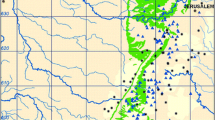Summary
Principal and reduced major axes, and Bulmer's (1975) tests have been suggested as methods for detecting the presence of density dependence in a series of population censuses that are unsuitable for analysis by alternative means e.g. by k-factor analysis. These alternative methods are tested using census data, some of which are previously unpublished, from natural populations known from independent evidence to be subject to density dependent processes. All the methods fail to detect density dependence reliably, irrespective of sample size and the dynamics of the population. We conclude that none of the methods tested is sufficiently reliable to be useful as a test of density dependence in sequential censues of animal populations.
Similar content being viewed by others
References
Boer PJ den (1986) Density dependence and the stabilisation of animal numbers. Oecologia (Berlin) 69:507–512
Bulmer MG (1975) The statistical analysis of density dependence. Biometrics 31:901–911
Dempster JP (1975) Animal Population Ecology. Academic Press, London
Dempster JP (1983) The natural control of populations of butterflies and moths. Biol Rev 58:461–481
Dempster JP, Pollard E (1986) Spatial heterogeneity, stochasticity and the detection of density dependence in animal models incorporating age structure. J Anim Ecol 52:479–495
Hassel MP (1985) Insect natural enemies as regulating factors. J Anim Ecol 54:323–334
Hassell MP (1986) Detecting density dependence. TREE 1:90–93
Hassell MP, Southwood TRE, Reader PM (1987) The dynamics of the viburnum whitefly [Aleurotrachelus jelinekii]: a case study of population regulation. J Anim Ecol 56:283–300
Klomp H (1965) The dynamics of a field population of the pine looper (Bulpalus piniarius L.) (Lepidoptera: Geometridae). Adv Ecol Res 3:207–305
Lawton JH, MacGarvin M, Heads PA (1986) The ecology of bracken-feeding insects: Background for a biological control programme. In: Smith RT, Taylor JH (eds) Bracken: Ecology, land use and control technology. Parthenon publishing, Carnforth, pp 285–292
May RM (1977) Thresholds and breakpoints in ecosystems with a multiplicity of stable states. Nature 269:471–477
McCleery RH, Perrins CM (1985) Territory size, reproductive success and population dynamics in the great tit, Parus major. In: Sibly RM, Smith RH (eds) Behavioural Ecology. Blackwell, Oxford, pp 353–373
McLellan CR (1977a) Trends of codling moth (Lepidoptera: Olethreutidae) populations over 12 years on two cultivars in an insecticide free orchard. Can Ent 109:1555–1562
McLellan CR (1977b) Trends of eye-spotted bud moth (Lepidoptera: Olethreutidae) populations over 12 years on two cultivars in an insecticide free orchard. Can Ent 110:91–100
Minot EO (1981) Effects of interspecific competition for food in breeding blue and great tits. J Anim Ecol 50:375–385
Morris RF (1959) Single-factor analysis in population dynamics. Ecology 40:580–588
Podoler H, Rogers D (1975) A new model for the identification of key factors from life-table data. J Anim Ecol 44:85–114
Ricker WE (1975) A note concerning Professor Jolicoeur's comments. J Fish Res Board Can 32:1494–1498
Royama T (1984) Population dynamics of the spruce budworm Choristoneura fumiferana. Ecol Monogr 54:429–462
Slade NA (1977) Statistical detection of density dependence from a series of sequential censuses. Ecology 58:1094–1102
Sokal RR, Rohlf FJ (1981) Biometry, 2nd Edition. Freeman WH, San Francisco
Southern HN (1970) The natural control of a population of Tawny owls (Strix aluco). J Zool 162:197–285
Stubbs M (1977) Density dependence in the life-cycles of animals and its importance in k- and r-strategies. J Anim Ecol 46:677–688
Varley GC, Gradwell GR (1983) Predatory insects as density dependent mortality factors. Proc. XVI. Int. Cong. Zool Washington, D.C. 1:240
Varley GC, Gradwell GR, Hassell MP (1974) Insect population ecology. Univ California Press, Berkeley
Vickery WL, Nudds TD (1984) Detection of density-dependent effects in annual duck censuses. Ecology 65:96–104
Williamson M (1972) The analysis of biological populations. Edward Arnold, London
Author information
Authors and Affiliations
Rights and permissions
About this article
Cite this article
Gaston, K.J., Lawton, J.H. A test of statistical techniques for detecting density dependence in sequential censuses of animal populations. Oecologia 74, 404–410 (1987). https://doi.org/10.1007/BF00378937
Received:
Issue Date:
DOI: https://doi.org/10.1007/BF00378937




